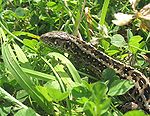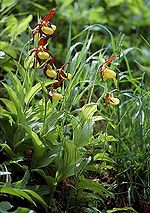Bird sanctuary Middle Isar reservoirs


The bird sanctuary in the middle Isar reservoirs is one of the most valuable water bird sanctuaries in Bavaria and is part of the European Natura 2000 network of protected areas .
expansion
The main habitats of the area are the Middle Isar Canal with the Moosburger Stausee and the Echinger Stausee as well as the Isar with adjoining alluvial forest areas. From a botanical point of view, the dry sites on the dams of the reservoirs and the Isar Canal are particularly important. Large parts of the protected area are man-made habitats that were built in the 1930s to generate electricity.
The bird sanctuary covers an area of around 5.7 square kilometers and is roughly equally located in the Freising and Landshut districts .
The protected area is of international importance as a resting and transit area and nationwide as a breeding area. It was placed under protection in 1982 with the aim of maintaining and improving the living conditions of the animal and plant species living there. A significant upgrade of the protection status took place through an amendment to the nature reserve ordinance in 1995, which forbids hunting waterfowl. The nature reserve is known far beyond the borders of Bavaria, especially among ornithologists. An extensive network of paths guarantees the accessibility of many areas of the protected area and enables nature lovers to experience interesting nature. An information booth can be found in Eching.
The Isar reservoirs

The middle Isar reservoirs between Moosburg and Eching form the core of the nature reserve. They are breeding grounds for numerous water birds, some of which overwinter here or migrate to the south. For example, the common tern was able to be reintroduced as early as 1975 through the creation of special nesting islands . It breeds at the two reservoirs every year with around a third of the entire Bavarian population in the nature reserve. The reservoirs are an important resting place for migrating bird species , some of which can cover thousands of kilometers between breeding and wintering areas. A special feature are the inland silt and mud areas that form in the reservoirs when the water is low and that are mainly used by waders . A large number of other bird species use the reservoirs as wintering areas. These regularly include several thousand water birds whose breeding areas are mostly in northeastern and eastern Europe.
The perineum areas
The dam areas run for a total of over 40 km along the reservoirs and the Isar. With regard to species protection, the gravelly, nutrient-poor dam crests along the Isar Canal and the reservoirs are particularly worth protecting. The south sides of the dams, which are heavily exposed to the sun, offer ideal habitats for warmth-loving animal and plant species. Characteristic animal species of these locations are the sand lizard and the smooth snake , botanically meadow sage and Carthusian carnation characterize the picture. Regular maintenance measures are required to maintain the open character of the dams. Otherwise, the sensitive communities will gradually be displaced by old grass and bushes .
The alluvial forests
About two square kilometers of alluvial forest are part of the nature reserve. Riparian forests are full of life from the roots to the tree tops and are characterized by the element of water: high groundwater levels and floods require special adjustments from animals and plants and are the basis for a particularly species-rich community.
The diverse forests, from the softwood floodplain dominated by willows to the hardwood floodplain with ash , elm , maple and other deciduous trees , form an ideal habitat for woodpecker species or the very hidden golden oriole , whose whistling reputation increases in May and June in the protected area is heard.
Threatened birds of prey such as the honey buzzard and tree falcon also breed in the alluvial forests. Rare plants thrive on the forest floor such as B. Orchids.
The Isar
The Isar crosses the nature reserve over a length of about 8 kilometers. As an alpine river with a comparatively high flow speed, it forms a large number of gravel banks that can also be relocated or washed away in the event of major floods. Gravel banks and the Nagelfluhfelsen at Siebenrippen are particularly valuable for nature conservation. They are potential breeding habitats for endangered species such as common sandpipers and little ringed plovers and are therefore not allowed to be entered. Various wading and water bird species use the gravel banks, shallow water and bank areas of the Isar for foraging. In summer, bats and tree falcons hunt across the river, and kingfisher and goosander can be seen here all year round. Since the Isar, unlike the reservoirs, does not freeze over in winter either, waders and water birds find an important alternative habitat here in severe frost.
Web links
Coordinates: 48 ° 29 ′ 46 ″ N , 12 ° 0 ′ 22 ″ E







